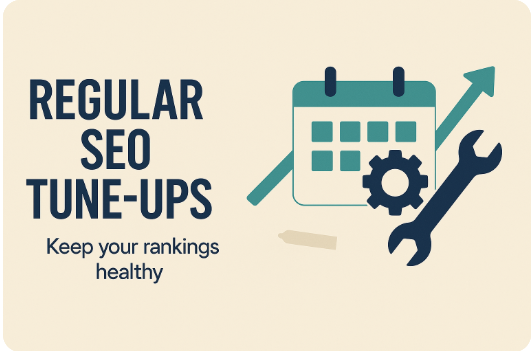In the ever-evolving digital landscape, search engine optimization (SEO) remains a cornerstone of successful online marketing strategies. Yet, many businesses mistakenly adopt a “set it and forget it” approach to SEO, treating it as a one-time task rather than an ongoing process. This perspective is not only misguided but also detrimental to long-term success. Regular SEO maintenance is essential for staying competitive, adapting to algorithm changes, and ensuring sustained online visibility. Here’s why it matters.
The Changing Nature of Search Engine Algorithms
Search engines like Google frequently update their algorithms to provide users with the most relevant and high-quality content. These updates range from minor tweaks to major overhauls, such as Google’s Core Updates or the introduction of the Helpful Content update. Without regular maintenance, your website risks falling out of alignment with the latest ranking criteria, leading to a drop in search engine rankings and organic traffic.
For example, if your website’s content isn’t optimized for the latest user intent signals or lacks the depth and authority that current algorithms prioritize, it may struggle to rank. Regular SEO maintenance allows you to monitor these updates and make necessary adjustments to your content, keywords, and technical structure to remain compliant and competitive.
Keeping Up with Keyword Trends
Keywords are the backbone of SEO, and their relevance evolves over time. Phrases that drove traffic a year ago may no longer resonate with your target audience or align with current search trends. Tools like Google Keyword Planner or SEMrush can help identify emerging trends and shifts in keyword performance.
Regular SEO maintenance involves revisiting your keyword strategy, analyzing search query data, and updating your content accordingly. This ensures that your website continues to attract the right audience and remains competitive in search results. Without this step, you risk wasting resources on outdated or ineffective keywords.
Enhancing User Experience (UX)
User experience is increasingly intertwined with SEO performance. Factors such as page load speed, mobile responsiveness, and intuitive navigation significantly impact your rankings. Regular maintenance helps identify and rectify UX issues that could harm your SEO.
For instance, a slow-loading website can lead to higher bounce rates, signaling to search engines that your content may not meet user expectations. Similarly, if your website isn’t optimized for mobile devices, you could lose valuable traffic, as mobile-first indexing is now a priority for search engines. By conducting routine audits and implementing improvements, you can enhance UX and, in turn, boost your SEO.
Preventing Technical Issues
Technical SEO forms the foundation of any successful optimization strategy. Broken links, duplicate content, missing metadata, and crawl errors are common issues that can silently sabotage your website’s performance. Regular SEO maintenance includes conducting technical audits to identify and fix these problems before they escalate.
For example, a 404 error on a key landing page not only frustrates users but also signals to search engines that your site’s quality may be subpar. Similarly, an improperly configured robots.txt file can inadvertently block search engines from indexing your site. By addressing these issues promptly, you ensure that your website remains accessible and optimized for both users and search engines.
Staying Ahead of Competitors
The digital marketplace is fiercely competitive, with businesses vying for top positions in search results. Regular SEO maintenance provides an opportunity to analyze competitors’ strategies and identify areas where you can outperform them.
Competitive analysis tools can reveal valuable insights, such as keywords your competitors are ranking for, their backlink profiles, and content gaps you can exploit. By staying proactive and refining your strategy, you can secure a competitive edge and capture a larger share of your target audience.
Maximizing ROI
SEO is an investment, and like any investment, it requires ongoing care to deliver optimal returns. Regular maintenance ensures that your efforts yield consistent results by adapting to changes in the digital landscape. Neglecting maintenance can result in declining performance, wasted resources, and missed opportunities.
For example, a well-maintained website with up-to-date content and optimized technical elements is more likely to attract and convert visitors, leading to higher revenue. On the other hand, outdated content or unresolved technical issues can erode user trust and diminish your ROI.
Building and Maintaining Authority
Search engines prioritize websites that demonstrate authority and trustworthiness. Regular SEO maintenance helps reinforce your authority by ensuring that your content remains relevant, accurate, and aligned with user intent. This involves updating outdated information, expanding on existing topics, and incorporating high-quality backlinks.
Backlinks, in particular, require ongoing attention. Regularly auditing your backlink profile allows you to identify and disavow harmful links, acquire new high-quality links, and strengthen your domain’s authority. Without this effort, your website’s credibility could decline, negatively affecting your rankings.
Adapting to Emerging Technologies
The digital landscape is constantly evolving, with new technologies and search behaviors emerging regularly. Voice search, artificial intelligence, and visual search are just a few examples of trends shaping the future of SEO. Regular maintenance ensures that your website remains adaptable to these changes.
For instance, optimizing for voice search requires a focus on conversational keywords and structured data, while visual search necessitates high-quality images and alt text. By staying ahead of these trends, you can position your website to capitalize on new opportunities and maintain its relevance in the digital ecosystem.
Strengthening Local SEO
For businesses targeting local audiences, regular SEO maintenance is crucial for maintaining visibility in local search results. This involves updating your Google Business Profile, monitoring online reviews, and ensuring consistent NAP (name, address, phone number) information across directories.
Neglecting local SEO can result in lost opportunities to connect with nearby customers, especially as search engines increasingly prioritize location-based results. Regular maintenance helps you stay visible and accessible to your local audience, driving foot traffic and conversions.
Tracking Performance and Making Data-Driven Decisions
SEO is inherently data-driven, and regular maintenance allows you to track performance metrics such as organic traffic, bounce rates, and conversion rates. Analyzing this data provides valuable insights into what’s working and what needs improvement.
For example, if certain pages experience a drop in traffic, regular monitoring can help pinpoint the cause, whether it’s algorithm changes, outdated content, or technical issues. Armed with this information, you can make informed decisions to optimize your strategy and achieve better results.
In closing:
In today’s dynamic digital environment, regular SEO maintenance is not a luxury but a necessity. It enables businesses to stay competitive, adapt to changes, and maximize the value of their online presence. By investing time and resources into ongoing optimization, you can ensure that your website remains a powerful tool for attracting and engaging your target audience.
Ultimately, the importance of regular SEO maintenance lies in its ability to drive sustainable growth and success. It’s an ongoing commitment that pays dividends in the form of increased visibility, higher rankings, and improved user satisfaction. So, if you’re serious about thriving in the digital age, make SEO maintenance a priority—your future success depends on it.
Frequently Asked Questions (FAQ):
Q: What does a data‑driven SEO strategy actually mean?
A: It means using real user and search data to decide what to optimise, create and fix — not guesswork. You measure what matters, test improvements, and keep iterating based on results.
Q: Which data sources should I rely on for SEO?
A: Use GA4 for traffic, engagement and conversions; Google Search Console for queries, rankings and indexing; Google Business Profile Insights for local performance; and tools like Ahrefs or SEMrush for keyword and backlink research. Add Looker Studio for dashboards and annotations.
Q: How do I set measurable SEO goals and KPIs?
A: Start with business goals (e.g. qualified enquiries). Map them to SEO KPIs like organic conversions, non‑branded traffic, priority keyword rankings, and local actions from GBP. Establish a baseline and set realistic 90‑day targets you can report on.
Q: How can I spot quick‑win opportunities in the data?
A: In Search Console, find pages with high impressions but low CTR and keywords in positions 5–15. Improve titles/meta, refine headings, and add internal links. In GA4, identify organic landing pages with traffic but weaker engagement or conversions and refresh them to better match search intent.
Q: What should I look for in content performance analysis?
A: Check which topics and formats convert, pages with declining traffic, and content that could be expanded. Refresh outdated information, add FAQs to capture common questions, and repurpose strong pieces into video, infographics or short posts to reach new audiences.
Q: How do I approach backlink profile analysis?
A: Audit for spammy or irrelevant links and disavow where necessary. Compare competitor backlink sources to find gaps. Build links through useful resources, digital PR, partnerships and guest content on relevant, high‑authority sites.
Q: Which technical SEO metrics matter most?
A: Core Web Vitals, mobile‑friendliness, crawl errors, index coverage, and site speed. Use Search Console to monitor issues and ensure your site is easy for Google to crawl and users to navigate.
Q: How do I measure local SEO performance?
A: Track calls, direction requests and website clicks in Google Business Profile. Add UTM parameters to GBP links, review performance of location pages in GA4, and monitor local pack rankings and reviews. Keep NAP details consistent across citations.
Q: How often should I review SEO data?
A: Do weekly health checks to catch issues, a monthly review to analyse performance and prioritise work, and a quarterly strategy reset to adjust targets, budgets and focus areas.
Q: How long until data‑driven SEO improvements show results?
A: Early movement can appear within 4–12 weeks, depending on crawl rate, competition and the scope of changes. Content, authority and technical gains typically compound over several months.



